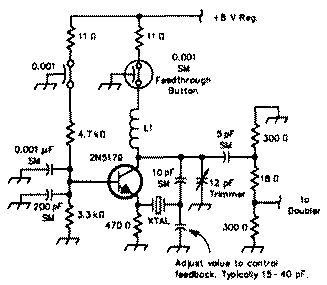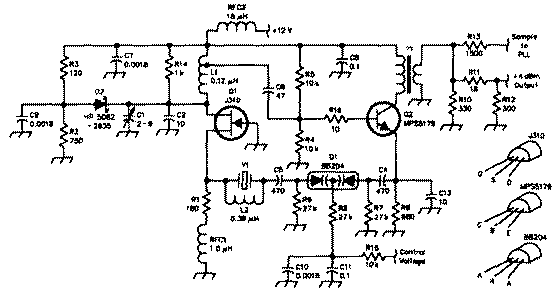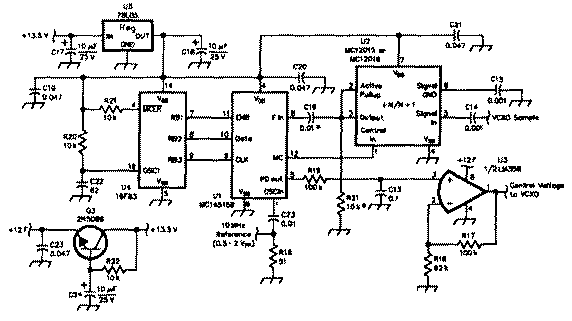
|
|
ENCYCLOPEDIA OF RADIO ELECTRONICS AND ELECTRICAL ENGINEERING Stable low noise crystal oscillator for microwave and transverters. Encyclopedia of radio electronics and electrical engineering
Encyclopedia of radio electronics and electrical engineering / Knots of amateur radio equipment. Generators, heterodynes In connection with the use by radio amateurs of narrow-band types of modulation CW, SSB, NBFM up to 411 GHz, it is especially important to ensure high stability of the local oscillator frequency in microwave transverters. A less well-known problem is phase noise, and most amateur radio oscillator designs have excessive noise levels that reduce the dynamic range of transverters. These problems are disclosed, and ways to solve them are proposed in 5 main sections of the article. In the section explaining the problem of phase noise, it is noted that millimeter-wave transverter oscillators typically operate at frequencies around 100 MHz and their phase noise level is a very critical parameter, because. a further doubling step increases the noise level in the signal by 6 dB. So, for example, successive doubling of a 100 MHz quartz frequency to 10 GHz will increase the output noise by almost 40 dB, and up to 250 GHz - by 68 dB or more. Common circuits of crystal oscillators provide a phase noise level of -155 dB / Hz relative to the carrier level (in terms of power). Multiplying to 245 GHz will degrade this parameter in the output signal to -87 dB/Hz. When using NBFM, for example, the noise level in the 16 kHz band will be (-87 + 42) dB, i.e. only 45 dB below carrier. In this case, the dynamic range of the receiver will be only 45 dB, and in the transmit mode, the radiated broadband noise will be 45 dB less than the level of the main signal. In the "Improving Stability" section, it is shown that quartz oscillators have a temperature instability of ±10 ppm (10-5) from 0°С to +70°С. This corresponds to ±100 kHz at 10 GHz, when multiplying a 100 MHz signal. Temperature compensation can achieve instability no worse than 0,3 ppm (3 * 10-7) or ±3 kHz at 10 GHz, or ±7 kHz at 24 GHz, or ±75 kHz at 250 GHz. A PLL system with a reference oscillator corresponding to the rubidium frequency standard will help to provide "stone" instability of the local oscillator. Such generators were used in obsolete radio navigation instruments and can be found in American illiquid stores. They have a temperature instability of ±10-9 or 0,001 ppm and allowed the author to achieve a long-term instability of ±250 Hz after multiplication on the amateur band 241...250 GHz. In the "Phase Noise Reduction" section, using the example of a traditional Butler quartz oscillator circuit on a bipolar transistor, it is shown (Fig. 1) that the noise level in the output signal determines mainly the noise of the input of the transistor, to which the signal from the quartz resonator is applied and noticeably decreases after increasing the resistance this entrance.
For the circuit in Fig. 45, the noise level is -155 dB / Hz, and after replacing the bipolar 2N5179 with a J310 common gate field effect transistor, the author received a phase noise level of -172 dB / Hz. The "VCO Circuit" section presents a circuit of a voltage-controlled oscillator (Fig. 2) - the main node of a low-noise PLL (low-noise phase-locked crystal oscillator - LNPLXO) crystal oscillator developed by the author.
The common-gate amplifying stage on Q1 provides a high input impedance to the signal from the Y1 quartz resonator, and the Q2 emitter follower provides a low VCO output impedance and, accordingly, a low resonator drive circuit resistance. Y1 is excited at the fifth harmonic of the series resonance, has an AT cutoff and C0=30 pF, R0<60 Ohm. The L1C1C2 circuit selects the necessary harmonic. R14 shunts it to improve linearity and sets the required gain of the POS generator circuit. Circuit D2C9R2R3 limits the amplitude of the undistorted output signal. The connection point R2R3 is set to 1,6V. When the peak RF signal at the drain of Q1 reaches -2V, D2 will open and limit the further increase in the amplitude of the output signal without changing the operating point of Q1, which has a positive effect on the linearity and noise characteristics of the generator. Using R2, you can choose the output signal level so that no more than 1 mW is dissipated on Y1. To ensure that the load effect on the VCO is minimal, the output signal is taken from the Q2 collector using a T1 9:1 transformer. The PLL system for LNPLXO (Fig. 3) is made according to the standard scheme.
Its basis is U1 (MC145158), including a frequency divider R of a signal of a highly stable rubidium reference oscillator (input 1/U1); DPKD for VCO frequency pre-divided by U2 chip into 20/21 (MS12019) or 32/33 (MS12015) (input 8/U1); phase detector - output 5/U1. The signal from the phase detector is fed to the LPF R19C13, the parameters of which do not quite correspond to the recommendations of Motorola and were selected experimentally taking into account the high quality factor of quartz in the VCO (Fig. 46). The PLL system is controlled by the PIC16F83 (U4) microcontroller, the control program for which (file STEP1199.ZIP) can be found at arrl.org/files/qex/. For the 24,192 GHz transverter, the author uses an anti-parallel diode mixer, while the heterodyne should operate at half the frequency, equal to 11,448 GHz with an IF of 1296 MHz. In order to obtain 46 GHz from the LNPLXO signal (Fig. 47, 95,4) with a frequency of 11,448 MHz, a multiplier by 120 is required. This is solved by successive multiplication by 2, 3,4 and 5. Author: John Stephensen (KD6OZH); Publication: N. Bolshakov, rf.atnn.ru
Artificial leather for touch emulation
15.04.2024 Petgugu Global cat litter
15.04.2024 The attractiveness of caring men
14.04.2024
▪ Greenhouse in which it is cool ▪ Add Magnesium to the Car Body ▪ Controlling waves in a magnet using superconductors ▪ Flexible and resilient power supplies
▪ section of the site Stories from the life of radio amateurs. Selection of articles ▪ article Young everywhere is dear to us. Popular expression ▪ What is unique about France in IX-XI? Detailed answer ▪ radish article. Legends, cultivation, methods of application ▪ article Secret ink. Chemical experience
Home page | Library | Articles | Website map | Site Reviews www.diagram.com.ua |






 Arabic
Arabic Bengali
Bengali Chinese
Chinese English
English French
French German
German Hebrew
Hebrew Hindi
Hindi Italian
Italian Japanese
Japanese Korean
Korean Malay
Malay Polish
Polish Portuguese
Portuguese Spanish
Spanish Turkish
Turkish Ukrainian
Ukrainian Vietnamese
Vietnamese



 Leave your comment on this article:
Leave your comment on this article: